New Cocrystals of Ligustrazine: Enhancing Hygroscopicity and Stability
Abstract
:1. Introduction
2. Results
2.1. Crystal Structure Analysis
2.1.1. TMP-PABA Cocrystal (1:2)
2.1.2. TMP-MABA Cocrystal (1.5:1)
2.1.3. TMP-DNBA Cocrystal (0.5:1)
2.2. Hirshfeld Surface Analysis
2.3. Theoretical Computation Study
2.4. Powder X-ray Diffraction (PXRD) Analysis
2.5. Differential Scanning Calorimetry (DSC)
2.6. FT-IR Analysis
2.7. Stability Test
2.8. DVS Analysis
2.9. Solubility Experiment
3. Experimental Section
3.1. Materials
3.2. Preparations
3.2.1. Preparation of TMP-PABA Cocrystal (1:2)
3.2.2. Preparation of TMP-MABA Cocrystal (1.5:1)
3.2.3. Preparation of TMP-DNBA Cocrystal (0.5:1)
3.3. Single-Crystal X-ray Diffraction (SXRD)
3.4. Theoretical Computation Study
3.5. Powder X-ray Diffraction (PXRD)
3.6. Differential Scanning Calorimetry (DSC)
3.7. Fourier Transform Infrared (FT-IR) Spectroscopy
3.8. Stability Experiment
3.9. Dynamic Water Vapor Sorption (DVS)
3.10. Solubility Experiments
3.11. HPLC Method
4. Conclusions
Author Contributions
Funding
Institutional Review Board Statement
Informed Consent Statement
Data Availability Statement
Conflicts of Interest
References
- Bolla, G.; Sarma, B.; Nangia, A.K. Crystal engineering of pharmaceutical cocrystals in the discovery and development of improved drugs. Chem. Rev. 2022, 122, 11514–11603. [Google Scholar] [CrossRef] [PubMed]
- Xu, J.; Shi, Q.; Wang, Y.A.; Wang, Y.; Xin, J.B.; Cheng, J.; Li, F. Recent Advances in Pharmaceutical Cocrystals: A Focused Review of Flavonoid Cocrystals. Molecules 2023, 28, 613. [Google Scholar] [CrossRef] [PubMed]
- Singh, M.; Barua, H.; Jyothi, V.G.S.S.; Dhondale, M.R.; Nambiar, A.G.; Agrawal, A.K.; Kumar, P.; Shastri, N.R.; Kumar, D. Cocrystals by Design: A Rational Coformer Selection Approach for Tackling the API Problems. Pharmaceutics 2023, 15, 1161. [Google Scholar] [CrossRef] [PubMed]
- Bofill, L.; de Sande, D.; Barbas, R.; Prohens, R. New cocrystal of ubiquinol with high stability to oxidation. Cryst. Growth Des. 2020, 20, 5583–5588. [Google Scholar] [CrossRef]
- Wang, J.; Dai, X.L.; Lu, T.B.; Chen, J.M. Temozolomide–hesperetin drug–drug cocrystal with optimized performance in stability, dissolution, and tabletability. Cryst. Growth Des. 2021, 21, 838–846. [Google Scholar] [CrossRef]
- Shinozaki, T.; Ono, M.; Higashi, K.; Moribe, K. A novel drug-drug cocrystal of levofloxacin and metacetamol: Reduced hygroscopicity and improved photostability of levofloxacin. J. Pharm. Sci. 2019, 108, 2383–2390. [Google Scholar] [CrossRef] [PubMed]
- Li, M.; Sun, J.; Kuang, W.; Zhou, L.; Han, D.; Gong, J. Drug–Drug Multicomponent Crystals of Epalrestat: A Novel Form of the Drug Combination and Improved Solubility and Photostability of Epalrestat. Cryst. Growth Des. 2022, 22, 5027–5035. [Google Scholar] [CrossRef]
- Putra, O.D.; Umeda, D.; Nugraha, Y.P.; Nango, K.; Yonemochi, E.; Uekusa, H. Simultaneous improvement of epalrestat photostability and solubility via cocrystallization: A case study. Cryst. Growth Des. 2018, 18, 373–379. [Google Scholar] [CrossRef]
- Sun, J.; Jia, L.; Wang, M.; Liu, Y.; Li, M.; Han, D.; Gong, J. Novel drug–drug multicomponent crystals of epalrestat–metformin: Improved solubility and photostability of epalrestat and reduced hygroscopicity of metformin. Cryst. Growth Des. 2022, 22, 1005–1016. [Google Scholar] [CrossRef]
- Yang, D.; Cao, J.; Jiao, L.; Yang, S.; Zhang, L.; Lu, Y.; Du, G. Solubility and stability advantages of a new cocrystal of berberine chloride with fumaric acid. ACS Omega 2020, 5, 8283–8292. [Google Scholar] [CrossRef] [PubMed]
- Cheng, Y.; Jiang, Y.; Zhang, B.; Rong, X.; Ding, Q.; Zhang, Z.; Wang, J.; Mei, X. Improving the Stability, Dissolution, and Bioavailability of Isotretinoin by Cocrystallization. Cryst. Growth Des. 2022, 22, 7469–7477. [Google Scholar] [CrossRef]
- Guo, C.; Zhang, Q.; Zhu, B.; Zhang, Z.; Bao, J.; Ding, Q.; Ren, G.; Mei, X. Pharmaceutical cocrystals of nicorandil with enhanced chemical stability and sustained release. Cryst. Growth Des. 2020, 20, 6995–7005. [Google Scholar] [CrossRef]
- Liu, L.; Zhang, Z.; Cheng, Y.; Jiang, Y.; Lu, L.; Wang, J.R.; Mei, X. Stabilizing L-Menthol by Cocrystallization: Supramolecular Cavities Succeeded in Retaining the Volatile Flavor. Cryst. Growth Des. 2022, 22, 7285–7297. [Google Scholar] [CrossRef]
- Ito, M.; Nambu, K.; Sakon, A.; Uekusa, H.; Yonemochi, E.; Noguchi, S.; Terada, K. Mechanisms for improved hygroscopicity of L-arginine valproate revealed by X-ray single crystal structure analysis. J. Pharm. Sci. 2017, 106, 859–865. [Google Scholar] [CrossRef]
- Qi, M.H.; Li, H.; Zhu, B.; Hong, M.; Ren, G.B. Cocrystals of Oxymatrine: Reducing Hygroscopicity and Affecting the Dissolution Rate. Cryst. Growth Des. 2021, 21, 3874–3888. [Google Scholar] [CrossRef]
- Wang, Z.Z.; Chen, J.M.; Lu, T.B. Enhancing the hygroscopic stability of S-oxiracetam via pharmaceutical cocrystals. Cryst. Growth Des. 2012, 12, 4562–4566. [Google Scholar] [CrossRef]
- Zou, J.; Gao, P.; Hao, X.; Xu, H.; Zhan, P.; Liu, X. Recent progress in the structural modification and pharmacological activities of ligustrazine derivatives. Eur. J. Med. Chem. 2018, 147, 150–162. [Google Scholar] [CrossRef] [PubMed]
- Zhang, Y.; He, L.; Ma, C.; Wang, C.; Zhou, H.L.; Guo, C.C.; Gong, L.H.; Wan, Y.; Peng, C.; Li, Y.X. Research progress on the pharmacy of tetramethylpyrazine and its pharmacological activity in cardiovascular and cerebrovascular diseases. J. Pharm. Pharmacol. 2022, 74, 843–860. [Google Scholar] [CrossRef] [PubMed]
- Feng, F.; Xu, D.Q.; Yue, S.J.; Chen, Y.Y.; Tang, Y.P. Neuroprotection by tetramethylpyrazine and its synthesized analogues for central nervous system diseases: A review. Mol. Biol. Rep. 2024, 51, 159. [Google Scholar] [CrossRef] [PubMed]
- Wu, J.; Cao, M.Y.J.; Peng, Y.; Dong, B.H.; Jiang, Y.X.; Hu, C.J.; Zhu, P.J.; Xing, W.D.; Yu, L.Y.; Xu, R.C.; et al. Research progress on the treatment of epilepsy with traditional Chinese medicine. Phytomedicine 2023, 120, 155022. [Google Scholar] [CrossRef] [PubMed]
- Zheng, Y.; Xie, L.; Yang, D.; Luo, K.; Li, X. Small-molecule natural plants for reversing liver fibrosis based on modulation of hepatic stellate cells activation: An update. Phytomedicine 2023, 113, 154721. [Google Scholar] [CrossRef] [PubMed]
- Hu, Y.; Wang, A.; Chen, J.; Chen, H. Ligustrazine: A Review of Its Role and Mechanism in the Treatment of Obstetrical and Gynecological Diseases. Clin. Exp. Obstet. Gyn. 2023, 50, 164. [Google Scholar] [CrossRef]
- Shi, J.W.; Zhang, Y.N.; An, Q.; Li, Y.J.; Liu, L.X. Improving the sublimation stability of ligustrazine with gallic acid by forming pharmaceutical cocrystal based on the Etter’s rules. J. Solid State Chem. 2024, 331, 124545. [Google Scholar] [CrossRef]
- Hu, S.Y.; Wang, C.G.; He, X.; Sun, C.C. Reducing the sublimation tendency of ligustrazine through salt formation. Cryst. Growth Des. 2020, 20, 2057–2063. [Google Scholar] [CrossRef]
- Wang, K.R.; Hao, Y.; Wang, C.G.; Zhao, X.H.; He, X.; Sun, C.C. Simultaneous improvement of physical stability, dissolution, bioavailability, and antithrombus efficacy of Aspirin and Ligustrazine through cocrystallization. Int. J. Pharmaceut. 2022, 616, 121541. [Google Scholar] [CrossRef] [PubMed]
- Zhang, Y.L.; Liu, H.; Chen, Z.X.; Meng, J.L.; Li, Y.F.; Qi, L.Y.; Zhang, S.L.; Chen, X.F.; Lei, M. A drug–drug cocrystal and a co-amorphous form, prepared from honokiol and ligustrazine, inspired by Chinese patent medicine. Acta Crystallogr. B 2023, 79, 519–524. [Google Scholar] [CrossRef] [PubMed]
- Li, X.J.; Liu, X.N.; Song, J.M.; Wang, C.G.; Li, J.H.; Liu, L.C.; He, X.; Zhao, X.H.; Sun, C.C. Drug-drug cocrystallization simultaneously improves pharmaceutical properties of genistein and ligustrazine. Cryst. Growth Des. 2021, 21, 3461–3468. [Google Scholar] [CrossRef]
- Rajkumar, M. Quaternary cocrystals of 3, 5-dihydroxybenzoic acid. Cryst. Growth Des. 2021, 21, 3547–3553. [Google Scholar] [CrossRef]
- Wang, L.; Xue, R.Y.; Li, Y.X.; Zhao, Y.R.; Liu, F.Q.; Huang, K.K. Hydrogen-bonding patterns in a series of multi-component molecular solids formed by 2, 3, 5, 6-tetramethylpyrazine with selected carboxylic acids. CrystEngComm 2014, 16, 7074–7089. [Google Scholar] [CrossRef]
- Sreekanth, B.R.; Vishweshwar, P.; Vyas, K. Supramolecular synthon polymorphism in 2:1 co-crystal of 4-hydroxybenzoic acid and 2, 3, 5, 6-tetramethylpyrazine. Chem. Commun. 2007, 23, 2375–2377. [Google Scholar] [CrossRef] [PubMed]
- Zheng, K.; Li, A.; Wu, W.; Qian, S.; Liu, B.; Pang, Q. Preparation, characterization, in vitro and in vivo evaluation of metronidazole–gallic acid cocrystal: A combined experimental and theoretical investigation. J. Mol. Struct. 2019, 1197, 727–735. [Google Scholar] [CrossRef]
- Salahinejad, M.; Le, T.C.; Winkler, D.A. Capturing the crystal: Prediction of enthalpy of sublimation, crystal lattice energy, and melting points of organic compounds. J. Chem. Inf. Model. 2013, 53, 223–229. [Google Scholar] [CrossRef] [PubMed]
- Marchese, R.L.; Roberts, K.J.; Martin, E.B. The influence of solid state information and descriptor selection on statistical models of temperature dependent aqueous solubility. J. Cheminform. 2018, 10, 44. [Google Scholar] [CrossRef]
- Oh, D.W.; Chon, J.; Kang, J.H.; Han, C.S.; Shin, D.H.; Kim, J.Y.; Rhee, Y.S.; Chun, M.H.; Kim, D.W.; Park, C.W. Physicochemical characterization of dapagliflozin and its solid-state behavior in stress stability test. Drug Dev. Ind. Pharm. 2021, 47, 685–693. [Google Scholar] [CrossRef] [PubMed]
- He, Y.; Chen, S.Y.; Li, M.M.; Gao, Y.H.; Feng, H.Y.; Umar, Q.; Yin, D.K.; Feng, Y.S. Novel co-crystal of 3-methylcinnamic acid with berberine (1: 1): Synthesis, characterization, and intestinal absorption property. Drug Dev. Ind. Pharm. 2023, 49, 617–627. [Google Scholar] [CrossRef] [PubMed]
- Yuan, P.H.; Wang, Y.Y.; Wang, W.W.; An, Q.; Li, S.; Zhang, B.X.; Zhou, J.; Hu, K.; Zhang, L.; Yang, D.Z.; et al. Characterization, Analysis, and Theoretical Calculation Studies of Solvates and Cocrystals of Betulin: An Exploration of the Boundary between Solvates and Cocrystals. Cryst. Growth Des. 2023, 23, 8694–8706. [Google Scholar] [CrossRef]
- Dolomanov, O.V.; Bourhis, L.J.; Gildea, R.J.; Howard, J.A.; Puschmann, H. OLEX2: A Complete Structure Solution, Refinement and Analysis Program. J. Appl. Crystallogr. 2009, 42, 339–341. [Google Scholar] [CrossRef]
- Bourhis, L.J.; Dolomanov, O.V.; Gildea, R.J.; Howardd, J.A.K.; Puschmann, H. The anatomy of a comprehensive constrained, restrained refinement program for the modern computing environment–Olex2 dissected. Acta Crystallogr. Sect. A 2015, 71, 59–75. [Google Scholar] [CrossRef] [PubMed]
- An, Q.; Xing, C.; Wang, Z.P.; Li, S.; Wang, W.; Yang, S.; Kong, L.L.; Yang, D.Z.; Zhang, L.; Du, G.H.; et al. Metformin-Mediated Improvement in Solubility, Stability, and Permeability of Nonsteroidal Anti-Inffammatory Drugs. Pharmaceutics 2024, 16, 382. [Google Scholar] [CrossRef] [PubMed]
- Wang, Z.P.; Li, S.; Li, Q.; Wang, W.W.; Liu, M.J.; Yang, S.Y.; Zhang, L.; Yang, D.Z.; Du, G.H.; Lu, Y. A Novel Cocrystal of Daidzein with Piperazine to Optimize the Solubility, Permeability and Bioavailability of Daidzein. Molecules 2024, 29, 1710. [Google Scholar] [CrossRef] [PubMed]

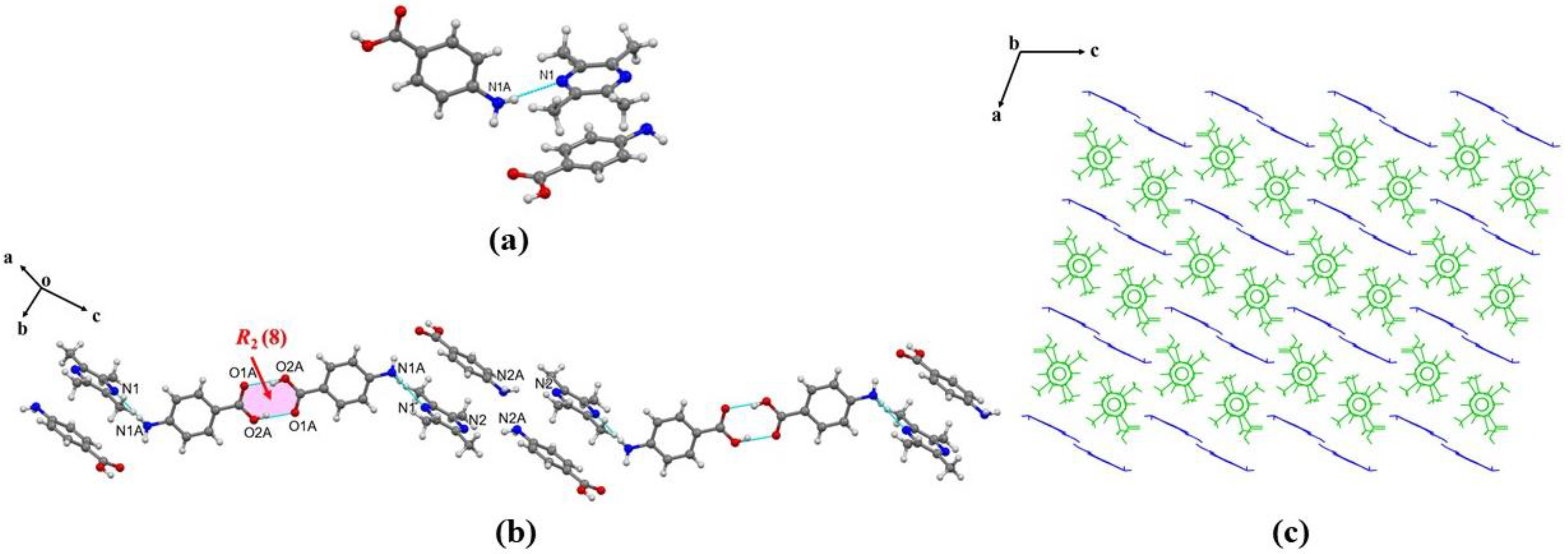

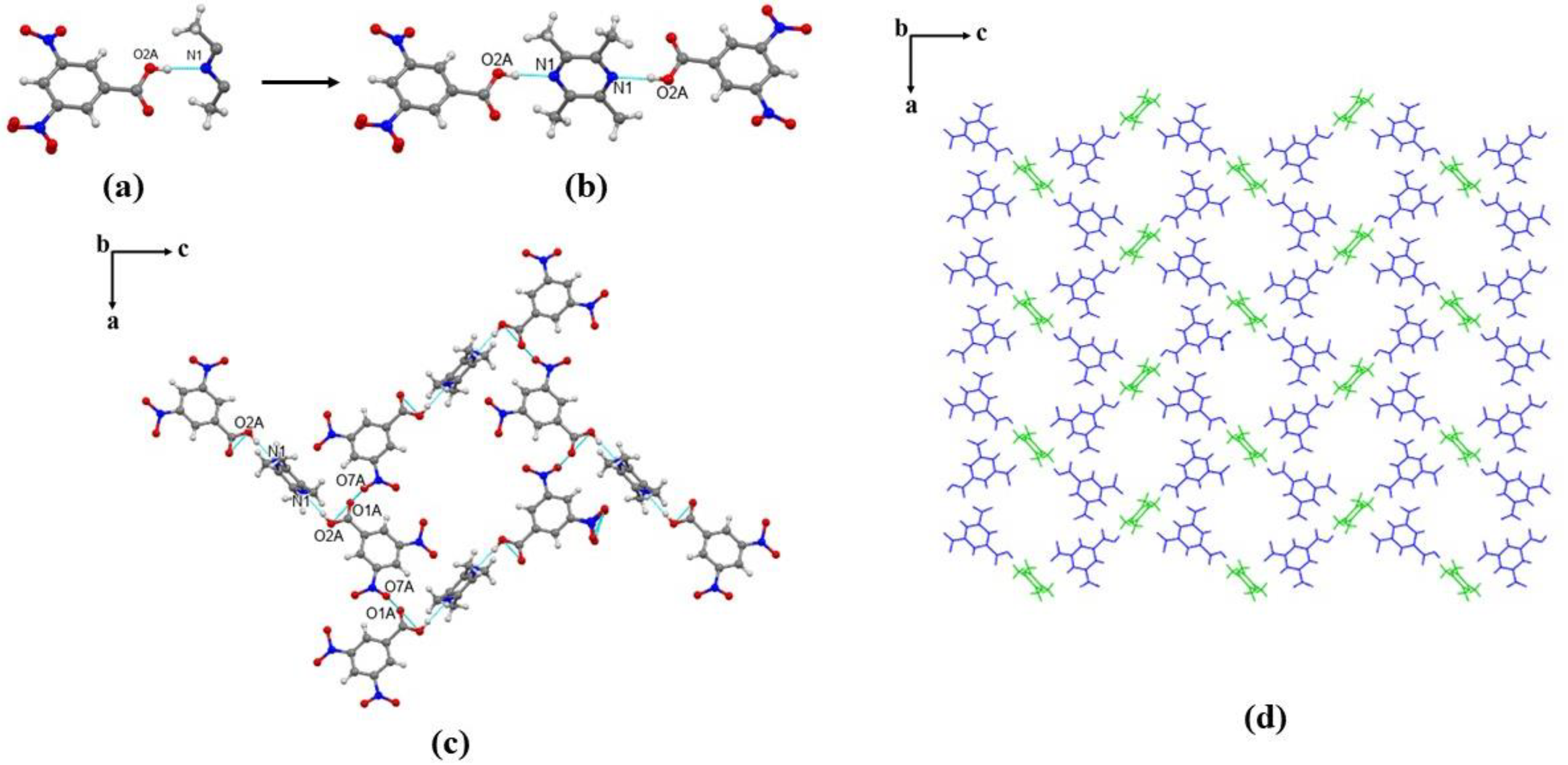
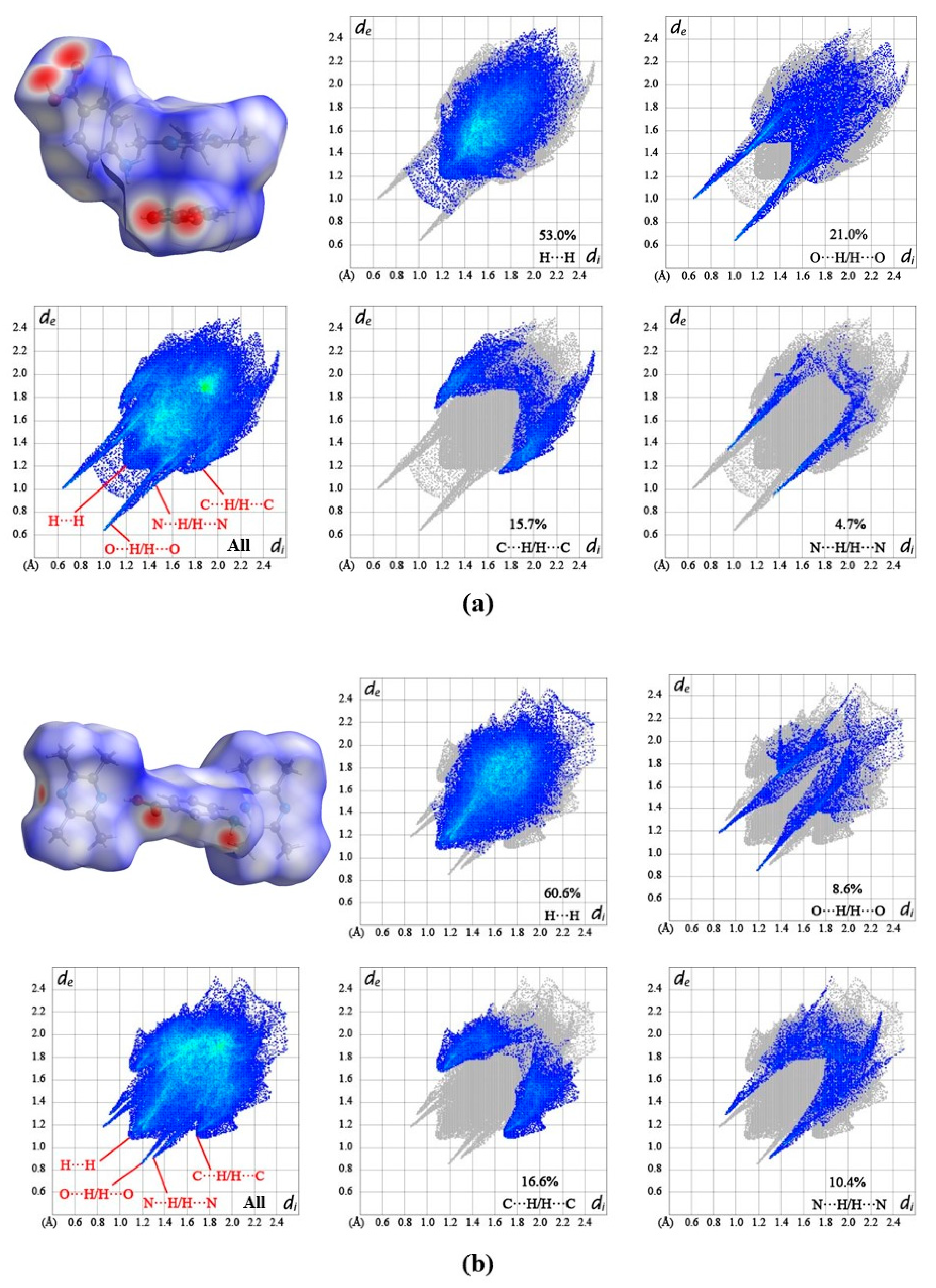
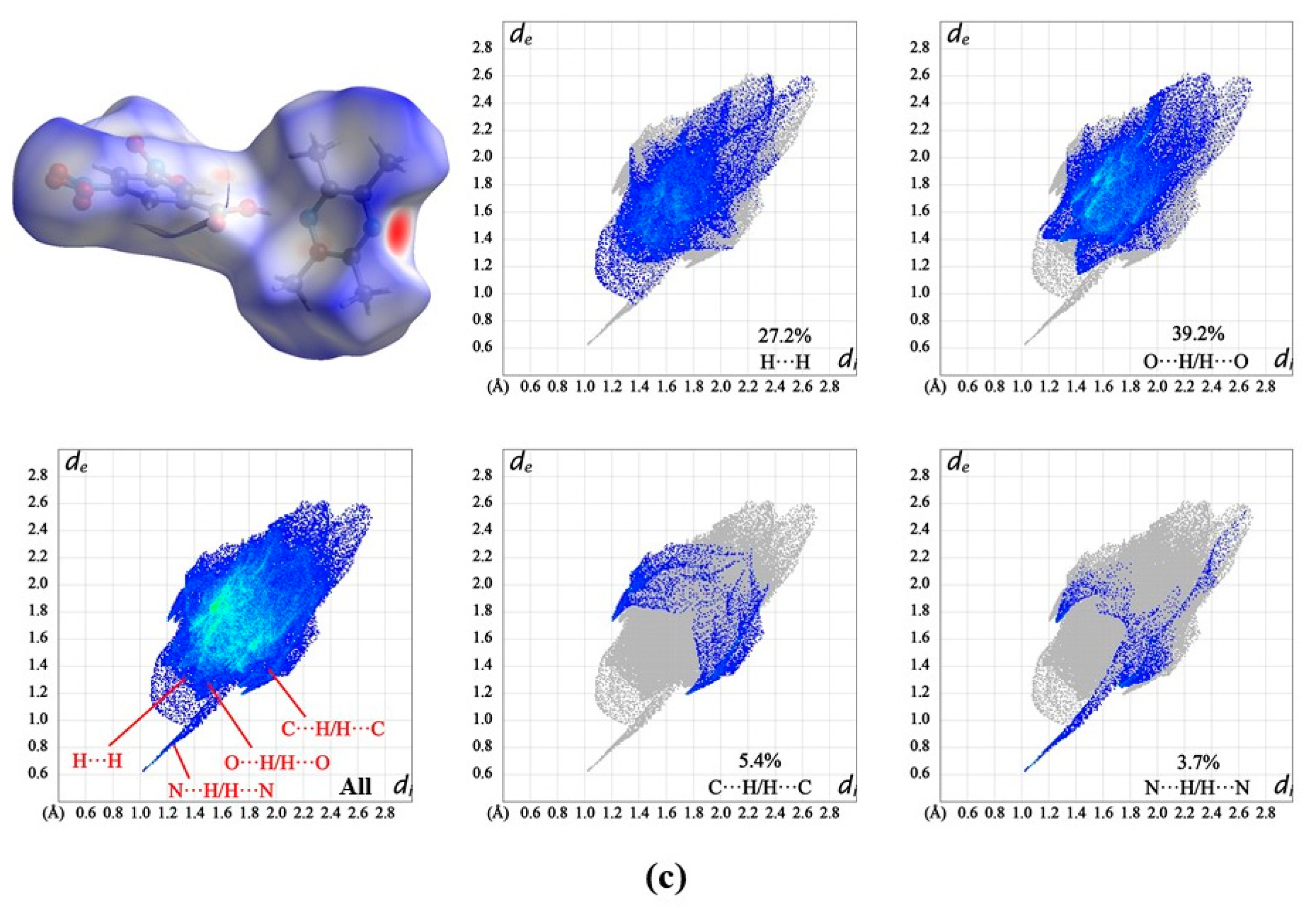
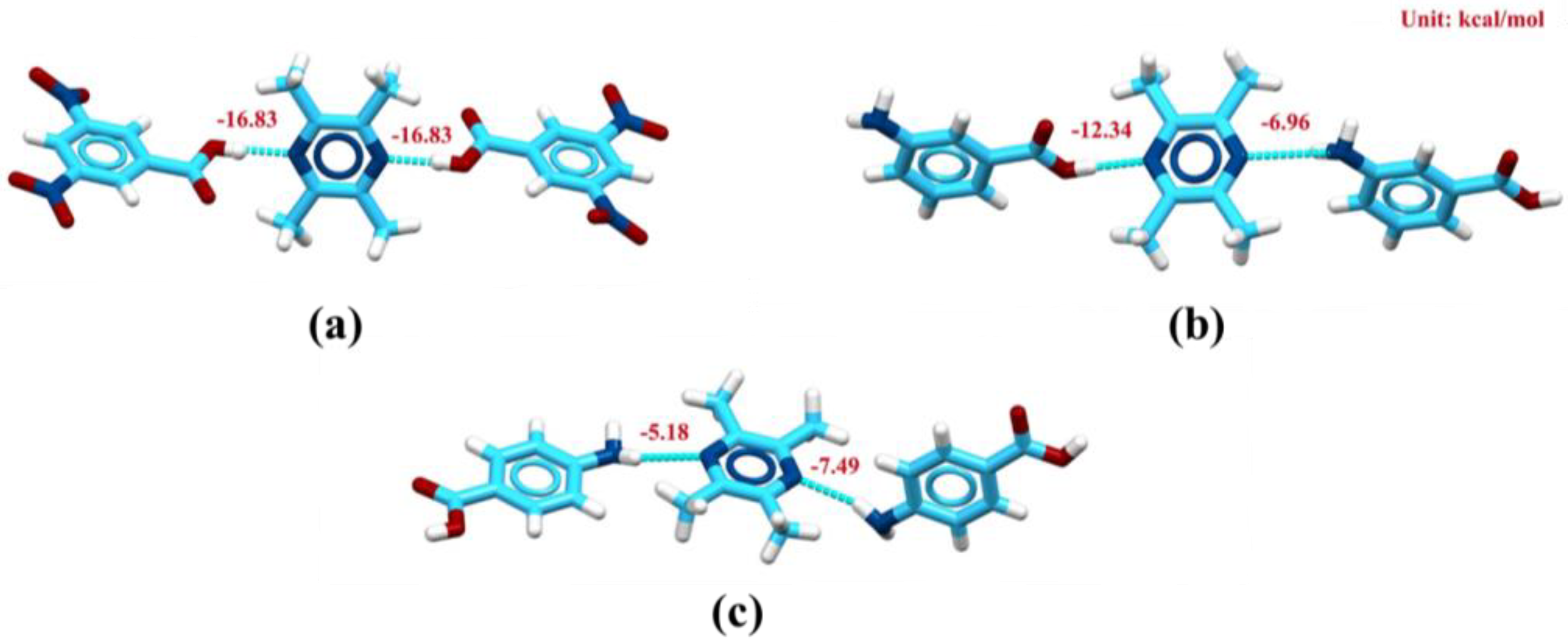

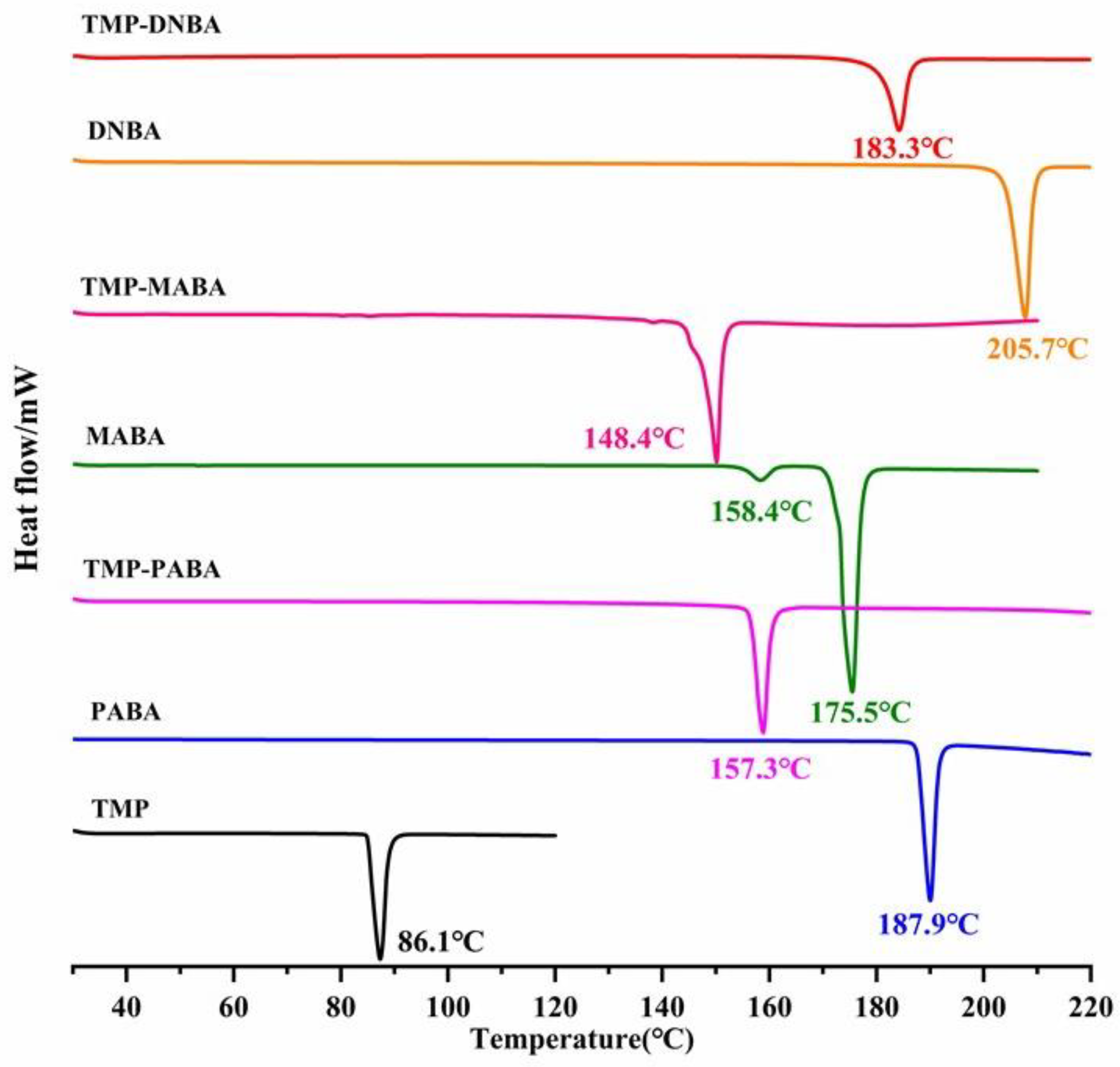

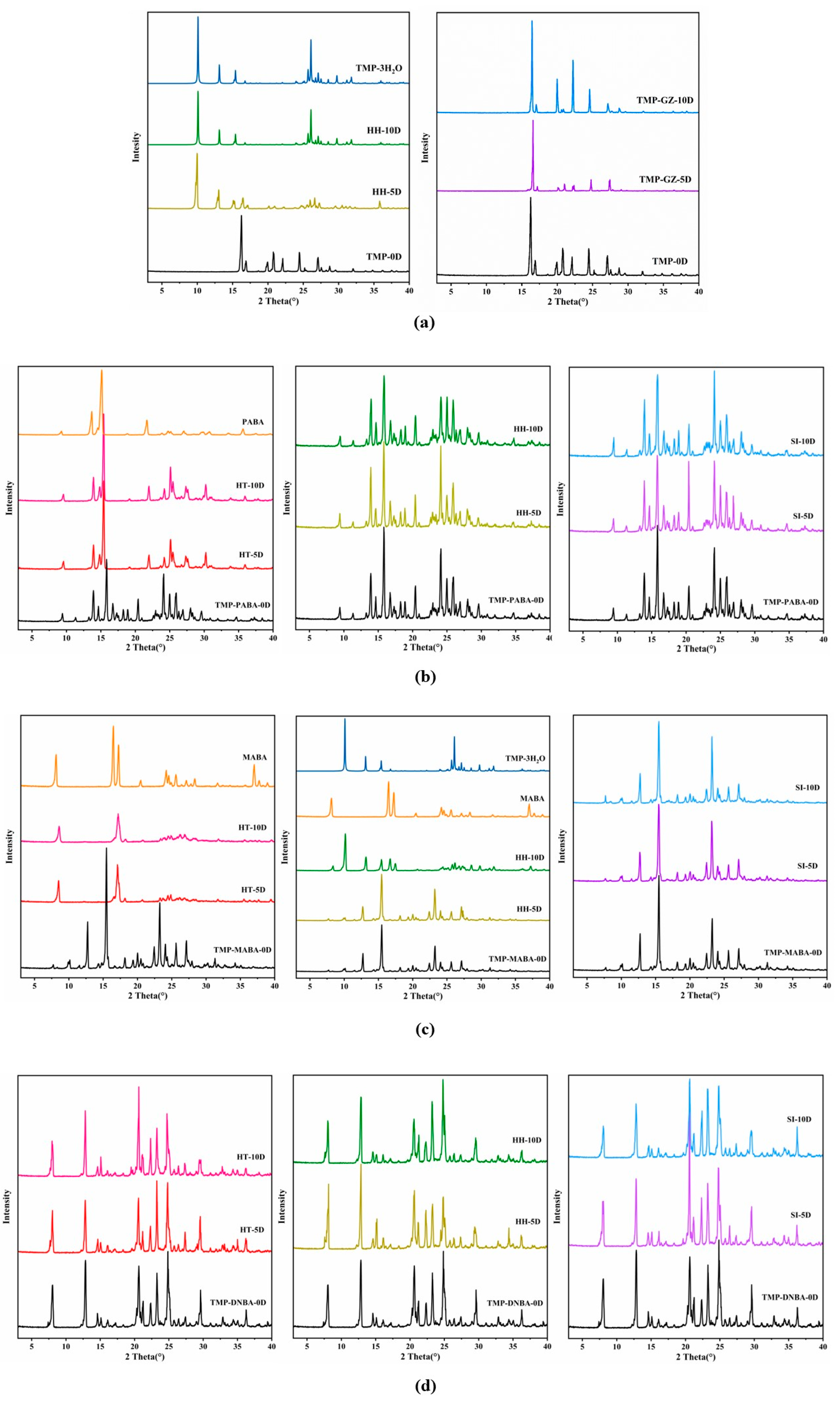


| TMP-PABA | TMP-MABA | TMP-DNBA | |
|---|---|---|---|
| empirical formula | C8H12N2·2(C7H7NO2) | 1.5(C8H12N2)·C7H7NO2 | 0.5(C8H12N2)·C7H4N2O6 |
| molecule weight | 410.47 | 341.43 | 280.22 |
| crystal size (mm) | 0.21 × 0.23 × 0.25 | 0.20 × 0.20 × 0.20 | 0.10 × 0.10 × 0.30 |
| temperature (K) | 302 | 304 | 293 |
| description | block | block | columnar |
| crystal system | monoclinic | triclinic | orthorhombic |
| space group | C2/c | P | Pbca |
| a (Å) | 23.217 (1) | 9.017 (1) | 13.888 (1) |
| b (Å) | 7.388 (1) | 9.449 (1) | 8.550 (1) |
| c (Å) | 25.917 (1) | 12.144 (1) | 22.094 (1) |
| α (deg) | 90 | 105.438 (2) | 90 |
| β (deg) | 100.597 (2) | 97.994 (2) | 90 |
| γ (deg) | 90 | 98.473 (2) | 90 |
| volume (Å3) | 4369.66 (17) | 968.98 (4) | 2623.46 (8) |
| Z | 8 | 2 | 8 |
| density (g/cm3) | 1.248 | 1.170 | 1.419 |
| independent reflections | 4445 | 3906 | 2659 |
| reflections with I > 2σ(I) | 3485 | 3158 | 2376 |
| Rint | 0.045 | 0.040 | 0.036 |
| final R, wR (F2) value [I > 2 σ(I)] | 0.059, 0.185 | 0.055, 0.176 | 0.044, 0.130 |
| goodness-of-fit on F2 | 1.046 | 1.064 | 1.037 |
| CCDC numbers | 2,339,277 | 2,339,276 | 2,339,275 |
Disclaimer/Publisher’s Note: The statements, opinions and data contained in all publications are solely those of the individual author(s) and contributor(s) and not of MDPI and/or the editor(s). MDPI and/or the editor(s) disclaim responsibility for any injury to people or property resulting from any ideas, methods, instructions or products referred to in the content. |
© 2024 by the authors. Licensee MDPI, Basel, Switzerland. This article is an open access article distributed under the terms and conditions of the Creative Commons Attribution (CC BY) license (https://creativecommons.org/licenses/by/4.0/).
Share and Cite
Xie, Y.; Gong, L.; Tao, Y.; Zhang, B.; Zhang, L.; Yang, S.; Yang, D.; Lu, Y.; Du, G. New Cocrystals of Ligustrazine: Enhancing Hygroscopicity and Stability. Molecules 2024, 29, 2208. https://doi.org/10.3390/molecules29102208
Xie Y, Gong L, Tao Y, Zhang B, Zhang L, Yang S, Yang D, Lu Y, Du G. New Cocrystals of Ligustrazine: Enhancing Hygroscopicity and Stability. Molecules. 2024; 29(10):2208. https://doi.org/10.3390/molecules29102208
Chicago/Turabian StyleXie, Yifei, Lixiang Gong, Yue Tao, Baoxi Zhang, Li Zhang, Shiying Yang, Dezhi Yang, Yang Lu, and Guanhua Du. 2024. "New Cocrystals of Ligustrazine: Enhancing Hygroscopicity and Stability" Molecules 29, no. 10: 2208. https://doi.org/10.3390/molecules29102208






